Reducing Rural Isolation in Nicaragua
Fermin Garcia Espinoza and the 3,000 person community of Rio Abajo in northern Nicaragua are celebrating a safe way to cross the Rio Pueblo Nuevo (River) for the first time in more than 16 years, thanks to a new pedestrian suspension bridge. Fermin, a Rio Abajo resident and father of five children, was one of several committed volunteers who worked with a team of North American bridge professionals from Buckland & Taylor | COWI and Kiewit Bridge & Marine to build the footbridge. Construction of the bridge, which is owned by the Municipality of Pueblo Nuevo and District of Rio Abajo, was coordinated by Bridges to Prosperity, a non-profit organization dedicated to reducing rural isolation through the construction of footbridges for communities in need. Rio Abajo was one of these communities in need, its access to major markets, secondary schools and healthcare services in the nearby town of Pueblo Nuevo impeded by the Rio Pueblo Nuevo during the rainy season between June and November. An existing bridge across the river was destroyed by Hurricane Mitch in 1998 and, since then, Rio Abajo residents had been forced to swim or wade across the river to reach Pueblo Nuevo. The only alternative was to complete a lengthy 5 mile walk to the town of Condega. Fermin remembers the daily problems associated with the lack of year-round access. The river crossing was risky during the peak of rainy season and items that were left on one side of the river so they wouldn’t get wet or ruined, such as shirts and papers, were often stolen. The new pedestrian bridge now provides Fermin and the rest of Rio Abajo with safe, year-round access across the river.
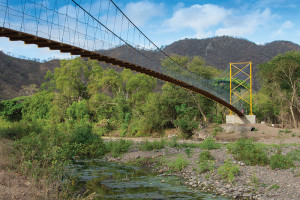
The new Rio Abajo Footbridge spans 265 feet over the Rio Pueblo Nuevo (River). Courtesy of Buckland & Taylor | COWI.
A Standardized, Efficient Bridge
The Rio Abajo footbridge closely matches Bridges to Prosperity’s standard suspension bridge design. Pedestrians, motorcyclists and livestock access the four foot wide bridge via masonry and cast-in-place concrete ramps at each abutment, and cross the river on a cable-supported deck composed of planks cut from tempisque, a local Nicaraguan hardwood tree. The planks are bolted to transverse double angle steel floor beams that transfer loads from the deck surface to the main cables through vertical steel bar hangers. The geometry of the walking surface is controlled by the length of the hangers, which are cut and bent on site to specific lengths to achieve the desired bridge profile. Fencing attached to the steel bar hangers ensures a safe crossing for bridge users. The main suspension cables, each consisting of three sheathed post-tensioning strands, pass over 30-foot-tall steel pipe towers to anchor into an at-grade reinforced concrete transition block. The towers are supported on reinforced concrete pedestals, and the cable loads from the transition block are transferred to a buried deadman anchor block.
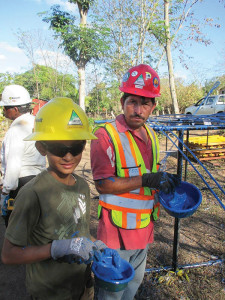
Fermin Garcia Espinoza paints steel bar hangers for the Rio Abajo footbridge. Courtesy of Ania Giffin.
Once the bridge foundations had been constructed by Rio Abajo community members with assistance from Bridges to Prosperity staff, a twelve person team of bridge engineers and constructors from Buckland & Taylor | COWI and Kiewit Bridge & Marine travelled to Rio Abajo in March 2015 to help the community construct the bridge superstructure in just eight construction days. The bridge was constructed during Rio Abajo’s dry season, which allowed the team to use the dry riverbed for site access. Upon arrival on site, the team of local volunteers and bridge professionals constructed temporary scaffolding towers that were used to erect and temporarily support the bridge’s steel pipe towers. Following tower erection, the main suspension cables were set to their correct elevation by measuring the distance from the top of the tower to the lowest point of the cable sag at mid-span and anchoring the cables to the anchor block. Pre-assembled steel bar hangers and transverse floor beams were installed, starting at each tower and working towards the middle using a pull cable. The hangers were attached to the pull cable at three foot intervals and slowly released down the slope of the main cable until the first hanger reached mid-span and the pull cable between each hanger was taut. This method proved efficient for installing the 81 hanger and floor beam assemblies to their required spacing. The bridge was completed by installing deck planks, fencing, and placing concrete for a transition ramp between the superstructure and approach ramps.
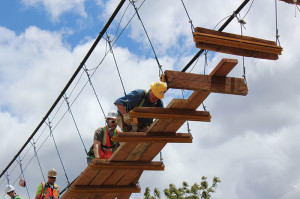
Build team members install deck planks made of tempisque, a local Nicaraguan hardwood. Courtesy of Abigail Conover.
Teaming Up to Reduce Rural Isolation
The Rio Abajo footbridge was constructed as part of Bridges to Prosperity’s Corporate Partnership program, which enables engineering and construction companies to help mitigate the worldwide problem of rural isolation. Bridges to Prosperity is a Denver-based non-profit organization founded in 2001 to address the global need for safe and reliable footbridge access across otherwise-impassible rivers. The World Bank, which tracks access to transport through the Rural Access Index (RAI), estimates that more than one billion of the world’s rural population do not have adequate access to transportation services. Bridges to Prosperity has been involved in the construction of more than 160 footbridges since its inception, typically partnering with student volunteers, corporate partners, and local governments. The footbridges act as catalysts for poverty-reduction by providing isolated communities with year-round access to healthcare, educational opportunities and major markets. To maximize the long-term sustainability of its bridge building programs, Bridges to Prosperity trains local masons, construction managers, and engineers about bridge construction, maintenance and rehabilitation.
Kiewit Bridge & Marine joined Bridges to Prosperity’s Corporate Partnership program in 2013 and Buckland & Taylor, a COWI North America company headquartered in North Vancouver, Canada joined in 2014. The two companies teamed up on the Rio Abajo bridge project by each sponsoring a portion of the required construction materials and sending staff to the bridge site to help the local community construct the bridge superstructure. The partnership of a bridge engineer and constructor proved valuable to the project’s success: Buckland & Taylor’s experience with the design and erection engineering of cable-supported structures was beneficial in providing a design review of the structure and its detailing before it was built, and helping with quality management during construction. Kiewit Bridge & Marine’s extensive construction experience allowed the Rio Abajo staff to successfully manage the site safety, work planning and resource allocation for the duration of the project.
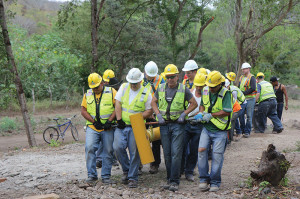
Community volunteers and bridge professionals team up to move the steel pipe towers. Courtesy of Abigail Conover.
Rio Abajo’s Bridge
The Rio Abajo bridge superstructure could not have been completed in just eight construction days without the enthusiasm and dedication of the volunteers from Rio Abajo. More than 150 families in the Rio Abajo community donated labor or supplies to the bridge project; one volunteer donated 30 days of his time to work on the bridge foundations and superstructure. The volunteers donned personal protective equipment, many for the first time in their lives, to safely work alongside the sponsoring companies’ staff. Many of the children from Rio Abajo were fascinated by the construction process and, after school was done for the day, contributed to the bridge by painting the steel bar hangers and assembling the crossbeams and hangers. The community was able to successfully work alongside the bridge professionals, despite the linguistic and cultural differences between the two groups. Much of the communication between the Spanish-speaking community volunteers and English-speaking bridge professionals was through a few bilingual members of the build team and several local Peace Corps volunteers. Rudimentary Spanish and hand gestures were also successfully used to convey bridge construction concepts. The high level of local involvement during bridge construction gave the Rio Abajo community a strong sense of ownership of the bridge, and means that the community will be more inclined to maintain and repair the bridge.
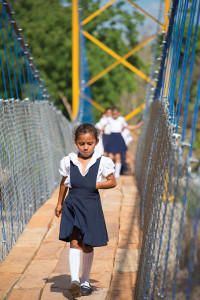
Schoolchildren cross the Rio Abajo Footbridge after the bridge inauguration. Courtesy of Buckland & Taylor | COWI.
Bridge Inauguration
The inauguration of the Rio Abajo footbridge, after its successful completion, was a joyful occasion for the 3,000 residents of Rio Abajo as they celebrated a year-round crossing over the Rio Pueblo Nuevo for the first time in more than 16 years. Members of the build team, local politicians, and the Rio Abajo community gathered at the bridge site for speeches, artistic performances, a ribbon-cutting, and even a piñata hung from the bridge. Don Bergman, Buckland & Taylor’s Senior Project Director and Vice President of Major Projects, travelled to Rio Abajo as part of the build team and remarked at the bridge inauguration ceremony “I’ve worked on many larger bridges around the world, but none have provided the sense of joy and satisfaction that the Rio Abajo bridge has.” That sense of joy and satisfaction is shared by the Rio Abajo community, including the Garcia family; Fermin and his family can cross the bridge to reach markets, schools and hospitals instead of having to swim or wade across the Rio Pueblo Nuevo. Fermin’s 17-year-old son Joel hopes to become a civil engineer, perhaps to design and build the next generation of footbridges for Nicaragua’s rural population.▪
For more information, please visit www.worldbank.org/transport/transportresults/headline/rural-access.html or
www.bridgestoprosperity.org/wherewework/central-america/nicaragua/rio-abajo
